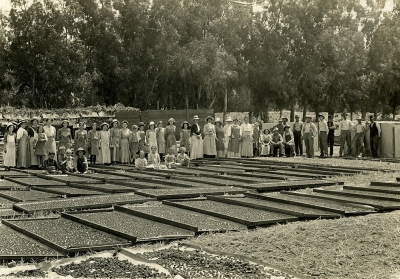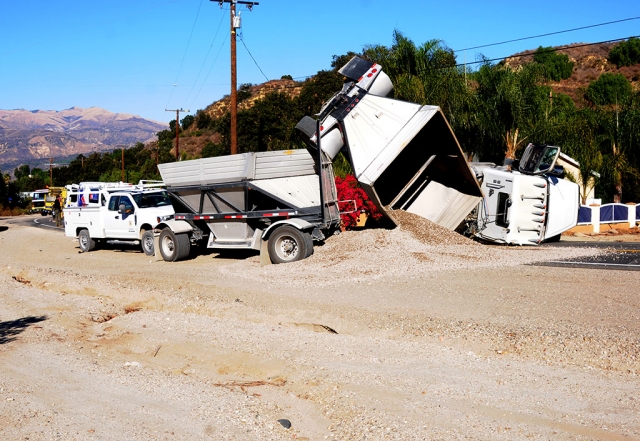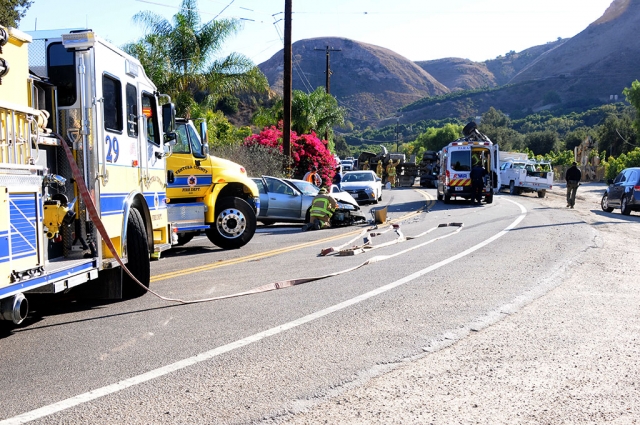 The Atmore home in Sespe purchased by Mathew Atmore. The Atmore family moved to the district in 1877. Photos courtesy Fillmore Historical Museum. Enlarge Photo By Anonymous — Wednesday, November 25th, 2020
Courtesy Fillmore Historical Museum Matthew Atmore as told to Charles Jarrett by his son, “Buck” Atmore in 1934. Prior to coming to our area, Mathew Atmore had an eventful life. He was one of four brothers who came to Michigan from England at an early age, settling in Kalamazoo, Michigan. He was just 15 when gold was discovered in California, and then began a life that was to be filled with adventure for many years to come. Parties were being organized everywhere to come to go California to search for gold and as the boy watched his older brothers making ready for he trip he determined that he would not be left behind. Secretly making his plans, he was all ready to run away and join a party when his father heard of it, and after presenting him with a hundred dollars, told him to go ahead. Crossing the plains with a wagon train, they reached Placerville in 1852. For four years he probably had about the same fortune as did the majority of gold seekers in California at that time. Books say the yellow metal was plentiful, but actual fortunes founded in Placerville were hard to find. It is likely that his mining ventures were about on a par with those of most “Forty-niners.” In 1856 he decided to leave California for good. He took a boat at San Francisco bound for Panama. Aboard the old side—wheeler were all sorts of returning gold seekers. Some were penniless, some played cards for high stakes, and the ranged from the resplendent suave card sharps and swaggering road agents, to the men who had stakedeverything to search for gold and were now returning , disillusioned, empty handed and aloof in their own misery, Two years back in Michigan was enough for Mathew Atmore, and in 1858 he landed in Placerville the second time. He started freighting mining machinery from Sacramento to Virginia City, but the way of Lake Tahoe and the American river. Driving six head of oxen to a wagon, it took him seven days to do the trip one way. Hay was $80 a tonand sold in bundles tied with rawhide. He received 20 cents a pound for his hauling. Driving an ox team over mountain roads was probably noteworthy for itsthrills, but a greater opportunity for adventure was soon to present itself. In 1861 he was turning his tired animals into the corral at Sacramento when word reached him that they were organizing the Second California Cavalry, and the regiment was all set to head for the south where it would be given an opportunity to help keep the Rebels on the run. Mathew apparently didn’t give the matter much consideration he simply locked the corral gate, sent word to one of his brothers he was going, and was gone. The Second California Volunteer Regiment of cavalry was soon to learn the fallacy of depending too much on army rumors. They weren’t needed just then to keep the Rebs on the run, but there were a lot of Indians whowerepot shooting the immigrants out in Nevada and, would the Second Regiment do something about it before they headed for the main event that was taking place below the Mason-Dixon line? The Second Regiment would, and did, but that attended to, they had another chore to do before they could go see about the war between the North and the South. The government wanted a fort built at Salt Lake City. Forone whole winter the brave cavalry men turned lumberjacks and hauled logs down from the mountains to build Ford Douglas and still stands a few miles out of the city (https://en.wikipedia.org/wiki/Fort_Douglas). After that they did manage to get in on a real fight. Some 700 Indians from a dozen tribes had banded together and they moved west through southern Idaho. The Indians had gone into winter quarters and two companies of the Second Californians were sent out to return them to reservation. During the ensuring fight, Atmore was thrown from a horse onto the frozen ground and broke his hip. Nowadays when a person breaks a bone they won’t let him bat an eye till it’s set and healed, but he had to take a four-day ride to Salt Lake City before he could have it attended to.The injury left one leg considerably shorter that the other for which the government awarded him six dollars a month pension during the later years of his life. He was mustered out at Fort Douglas in 1864 and returned to Michigan where he married Mary Elizabeth Gorham two years later. While in Michigan, they had 4 children, Haydee, Grace, Fred (Buck), and Ruby who died in infancy. The Atmore family moved to this district in 1877, when Mathew Atmore purchased a relinquishment on a homestead located where the Calumet oil lease is now. Due to some error in the land titles he lost the ground he had located on, and a year or so later purchased a relinquishment on 80 acres of land located near the present Atmore place in Sespe. |
 Above are some of the toys that were collected from last year’s Holiday Toy Drive with Santa’s helpers loading up the truck. Enlarge Photo By Anonymous — Wednesday, November 18th, 2020
The Fillmore Fire Department in conjunction with the Fillmore Fire Foundation is kicking off the annual Holiday Toy Drive this week. Collection drop off boxes for new toys are available at the Fillmore Police and Fire Stations. As part of the Toy Drive, on Sunday, December 6th, the Fire Department will be holding the annual Chicken Dinner Fundraiser to collect donations that are used to purchase hundreds of toys for children in the Fillmore/Piru area. A complete chicken dinner meal is prepared for anyone wanting to donate ten dollars ($10) that will be used to purchase a new toy. Because of necessary COVID-19 precautions, this year the dinner will be held at the Fillmore/Piru Veteran’s Memorial Building City, 511 Second St. Dinner will be served from 4:30 -7 PM. Again, due to COVID-19 restrictions, all meals will be for take-out only and will be available via a contactless drive-thru process. For this year only, we are requesting a monetary donation in lieu of a new toy to avoid less person to person contact. The hundreds of toys purchased from this event will be combined with those that are donated by the Community and then distributed the following week on Saturday, December 12, in a huge Community Holiday Giveaway event. The Holiday Giveaway event will also be a drive-thru and reservations are mandatory. To order your tickets for the December 6th BBQ Chicken Dinner call 805-524-1500 ext 226. To register for the Community Holiday Giveaway, go to recreation@fillmoreca.gov and leave a message. |
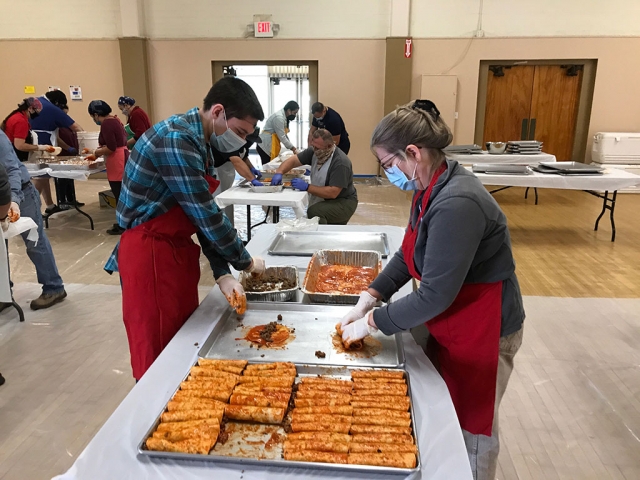 Fillmore Lions Club held their Annual Enchilada Dinner at the Veterans Memorial Building on Saturday, November 7th. Due to the COVID-19 pandemic, this year’s dinner was slightly different—no sitting and eating together as they had in past years. Volunteers James and Colleen Chandler are shown assembling enchiladas. Enlarge Photo By Anonymous — Wednesday, November 18th, 2020
Saturday, November 7th, the Fillmore Lions Club pulled off their annual Enchilada Dinner with a few changes. With the help of several volunteers and Lions members, close to 500 drive through meals were served. Ticket sales were one of the best of all time. Community members were happy to support this fundraiser and eat some delicious food while doing so. Lions would like to thank Christine and David Landeros for cooking the meat and Chuy from El Pescador for cooking the rice, beans, and sauce. Proceeds from the Lions enchilada dinner help out local community organizations and clubs. Lions meet the 1st and 3rd Monday at 7pm every month. If you’d like to learn more about Fillmore Lions Club, please visit www.fillmorelionsclub.org. |
|
By Anonymous — Wednesday, November 18th, 2020
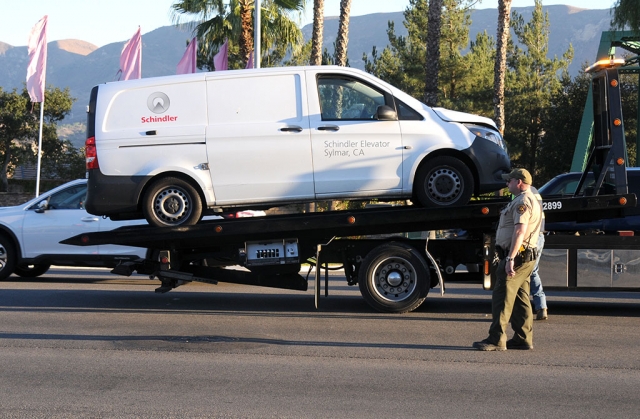 On Wednesday, November 11th at 3:44pm a collision occurred at the intersection of Mountain View and Ventura Street involving at least four cars. Pictured is a white Schindler Elevator work van being towed away from the scene and (below) a dark colored SUV which was also involved in the crash. Cause of the accident is still under investigation. Enlarge Photo |
 Pictured above is a mural in progress just outside Nova Storage at 455 A Street. Fillmore artist, musician and activist Gabriel Cardenas is the one responsible for this beautiful artwork. Enlarge Photo By Anonymous — Wednesday, November 18th, 2020
Nova Storage is at it again. After the initial historic fruit label mural was so well received by the community, Nova committed to a public art project consisting of several more murals to be painted at 455 A St. The program was approved by the City of Fillmore Arts Commission on August 26th. Nova Storage reached out to the community by conducting an online poll where people voted on their favorite historic fruit label design. The community’s response was greater than expected and the winner was the SESPE label. Coming soon. Talented local Fillmore artist, musician, and “artivist” Gabriel Cardenas of Fillmore will once again be beautifying another wall with the painting of the SESPE label. This mural, which began its process this past Saturday, November 14th, is one of a total of four murals scheduled to be painted on the Nova Storage property. “Being part of the communities we serve is something we embrace at Nova Storage”, said Sam Arias – Sales & Marketing Manager for Nova. “Due to Covid- 19, we were unable to incorporate an Art Student Workshop on “How to Paint a Mural” as we had planned, but when it’s safer we will collaborate with Fillmore High School’s Visual & Performing Arts Dept. Chair Rosalind Mitzenmacher on future mural paintings”. Nova Storage continues to be active in their local communities, with nine branches providing superior customer service and offering clean, safe and secure facilities at a great rate. Stop by one of their locations, like them on Facebook, follow on Instagram, and visit their website at www.NovaStorage.com. |
 Pictured above (l-r) are Theresa Robledo, Julie Latshaw, Martha Richardson, Ari Larson and Cindy Blatt of Fillmore Rotary Club who passed out books to Fillmore students as part of their Annual Dictionary Project. Enlarge Photo By Anonymous — Wednesday, November 18th, 2020
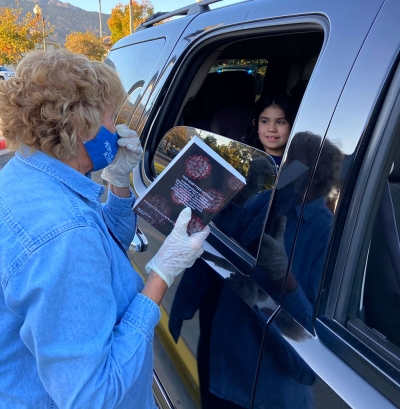 Rotary member Martha Richardson is shown handing a book to a Fillmore student as they drive by. Enlarge Photo The Rotary Club of Fillmore just completed their Dictionary Project. For several Years the Club has participated in this project. Members present a dictionary to each 3rd grader in the school district. This year, because of Covid-19, instead of going to each classroom members distributed the dictionaries during each schools distribution day. Each book has a label inside with Rotary’s 4-Way Test. The Club has been doing this project for close to 20 years and during that time we have donated 5,928 dictionaries to 3rd graders in Fillmore and Piru. |
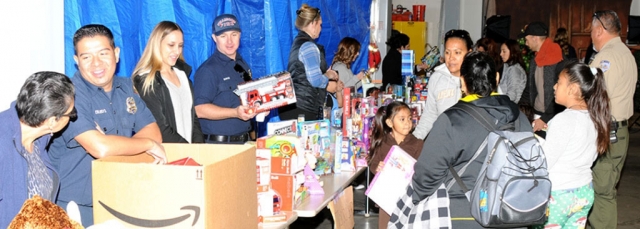 Pictured above is last year’s Annual Holiday Giveaway which will be held Saturday, December 12th from 9am to 12pm at the Veteran’s Memorial Building. Enlarge Photo By Anonymous — Wednesday, November 18th, 2020
This year’s annual Fillmore Community Holiday Giveaway will be held Saturday, December 12th from 9 AM – 12 PM outside of the Fillmore/Piru Veteran’s Memorial Building, 511 Second St. This is the annual event where holiday commodities are given to the children who reside within the Fillmore Unified School District boundaries. Due to COVID-19 restrictions, the location and format of the Giveaway has changed. This event will be a drive-thru, contactless format. Anyone wishing to receive holiday commodities must preregister prior to December 9th. The age and gender of each child will need to be identified so that age appropriate toys and socks may be pre-package for pick up. Because of COVID-19 restrictions, personal sizing of coats will not be available, instead, nice warm individual blankets will be distributed to each child. As is customary, a holiday bag of groceries will also be available. To ensure that Santa is well for Christmas delivery of toys, he will only be available to wave at the children from a distance this year. Everyone must remain in their vehicle. To preregister for the Giveaway send an email to recreation@fillmoreca.gov, you must provide proof of residency within the School District. Annual sponsors of the event include our local Fillmore Police and Fire Departments, Santa Clara Valley Legal Aid, One Step A La Vez, Soroptimist International of Fillmore, Rotary International of Fillmore, Fillmore Lions Club, Ventura County Deputy Sheriff’s Association, Fillmore Citizen’s Patrol, The Fillmore Fire Foundation and numerous other generous personal and business donors including NOVA Storage. Our sponsor list will be updated week to week. If you would like to help donate to the Fillmore Community Holiday Giveaway, you may give new toys, socks or canned food; drop boxes are located at the Fillmore Police Station and at the Fillmore City Fire Station. Monetary donations are preferred this year to reduce person to person contact, checks may be made out to “The Fillmore Fire Foundation” with a notation of “Holiday Giveaway”. Donations may be mailed to Fillmore Fire Foundation, PO Box 331, Fillmore , CA 93016 or for drop off, please contact Scott Beylik (805) 732-1101 or Keith Gurrola (805) 558-0932. |
|
By Anonymous — Wednesday, November 18th, 2020
Courtesy Fillmore Historical Museum Before there was citrus in this valley, there were apricots. Apricots came to Ventura County with the Missions and spread throughout the county with the settlers. David Cook planted apricots on his property in Piru in the early 1890s. He advertised “far and wide” in 1897 for workers for a two-week season, promising accommodations: “a pleasant and safe environment for most timid and refined ladies”. The accommodations were tents. He received three hundred applications. Pitting started upstream on Piru Creek and moved down as fruit ripened. In 1893, S. A. Guiberson planted apricots and spent $1000 perfecting and patenting a pitting machine. By 1900 there were 290 acres planted in Bardsdale. Families with apricot orchards besides the Guibersons were the Bartels, Baldeschweiler (Balden), Daugherty, Stuart, Grimes, Michels, LeBards, Stolls, and Wengerts. Joseph McNab had a pitting shed in Fillmore on the corner of First and Saratoga. Tommy Arundell in Pole Creek was known for apricots which made the pitters drool. Families came from as far away as Los Angeles in the late 19th and early 20th century to work in the apricot harvest. For many it was seen as a paid vacation from city life with housing provided by the ranchers. In July 1904 it was reported that the apricot harvest was in full swing with the employment of hundreds of people young and old. There were said to be 500 pitters at work in the orchards near Piru alone. By 1912 the citrus crop far outstripped apricots and other “deciduous fruits”. That year the sale of citrus fruits from Ventura County exceeded $37 million in value, while deciduous fruits were a mere $18 million. The apricot harvest went on through the 1940s, although losing ground to the citrus industry, just as it seems today citrus is giving way to avocadoes. During the years of World War II, the local populace turned out to harvest the apricot crop, much of which was dried and sent overseas to the troops. |
|
By Ventura County Sheriff Department — Wednesday, November 11th, 2020
Sheriff’s deputies responded to a hit and run traffic collision on Tuesday, November 3rd, in the city of Fillmore which led to the arrest of a 20-year-old Fillmore man for auto theft, hit-and-run resulting in injuries, and petty theft. On November 3rd, at approximately 6:29 a.m., patrol deputies were dispatched to the area of Mountain View Street and Ventura Street in the city of Fillmore for a report of a driver who fled on foot after his vehicle struck a pole. Around the same time, a second collision was reported nearby. As deputies arrived on scene, a male later identified as Isaiah Avalos, was seen running from the area. Detectives from the Fillmore Police Station responded to assist with the investigation and to locate Avalos. Deputies and detectives found Avalos nearby and attempted to contact him, but he evaded them. After a lengthy foot pursuit, Avalos was taken into custody. Deputies and detectives discovered Avalos had been reported as a missing at-risk person and the vehicle he had been driving was an unreported stolen vehicle. Avalos was also discovered to be involved in a crime spree involving multiple thefts from vehicles, in addition to another hit and run collision, and vehicle tampering. Detectives are currently investigating these cases. Avalos was arrested and booked at the Main Jail for VC 10851(a) / Unlawful Taking of a Vehicle, VC 20001(a) / Felony Hit and Run, VC 20002(a) / Misdemeanor Hit and Run and PC 484(a) / Petty Theft. Avalos remains in custody with his bail set at $25,000 and a court date scheduled for 11/17/20. Nature of Incident: Stolen Vehicle, Hit and Run and Petty Theft Arrest Ventura County Crime Stoppers will pay up to $1,000 reward for information, which leads to the arrest and criminal complaint against the person(s) responsible for this crime. The caller may remain anonymous. The call is not recorded. Call Crime Stoppers at 800-222-TIPS (8477). |
|
By Anonymous — Wednesday, November 11th, 2020
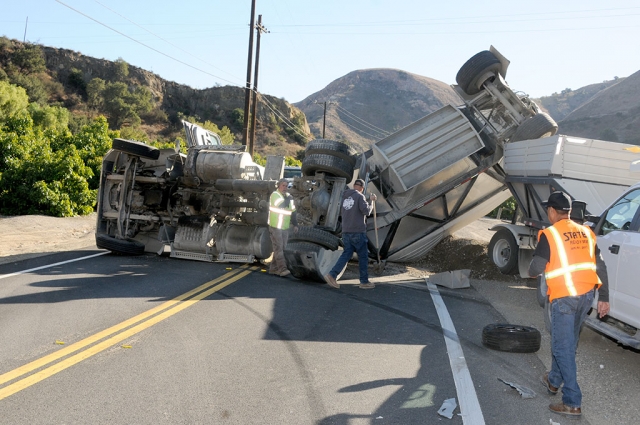 On Tuesday, November 10th at 1:46pm, in the 1700 block of Grimes Canyon Road in Bardsdale, a belly dump truck carrying a full load of gravel, and a grey Toyota Camry collided causing the truck to roll on its side, blocking lanes in both directions. The Camry had severe front-end damage. Cause of the crash is still under investigation. Lanes were to be impacted until possibly 10pm according to the California Highway Patrol. Enlarge Photo |









